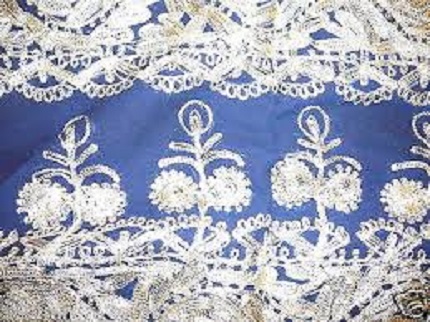The inhabitants of Damascus countryside excelled in several professions that were originally devised to satisfy the needs of people and which, later, became a real arts in themselves. The availability of local materials in the governorate helped craftsmen to develop these professions and turn them into artistic crafts inherited by the sons from the fathers and grandfathers.
Wherever you go in Damascus and its countryside you will see different products of these crafts that express the real expertise of their makers who always proved that they are talented and can develop their professions successfully: glassware, wood carving, marble sculptors and Arabic thread, brocade and damask that derived its name from Damascus, swords, kelims and carpets leather wear ….etc. Two of the most important of these crafts are mosaics and aghabani.
Mosaics:
Mosaics making is a handicraft that developed with the passage of time and could diversify its products to be used in every house and to occupy the head of the list of souvenirs and artifacts that tourist accompany with them when they leave Syria.
The profession depends on the availability of special kinds of wood, namely lemon and walnut, whose trees are abundant in the governorate of Damascus Countryside, and a good experience in industrializing animal bones, mother of pearl, ivory and dyes.
 A worker in this profession should have a good capability of calculations and measurement, deep awareness of symmetry and, of course, an artistic talent. Mosaics makers manufacture the pieces of wooden boxes, chairs, tables, chess boards, show cases, stationary holders and an endless list of things.
A worker in this profession should have a good capability of calculations and measurement, deep awareness of symmetry and, of course, an artistic talent. Mosaics makers manufacture the pieces of wooden boxes, chairs, tables, chess boards, show cases, stationary holders and an endless list of things.
Before joining them together they manufacture small rods of wood, melted bones, ivory ( now colored plastic is used), in certain cross sections: triangular, square, round, hexagonal or what ever they want. Rods are the joined in bundles that also take several shapes of cross section as the design requires. These bundles are sliced horizontally into very thin layers, less than half a millimeter thick.
The next step is to make larger slices that match in area the pieces of wood of the object being manufactured, stuck on them by glue, and pressed on wood. Pieces of wood are then assembled in the required shape, smoothened by sand paper and glossed by lacquer.
 The most beautiful and most costly mosaics are those inlaid with mother of pearl or ivory. Pieces are made of good walnut wood, well dried and brown dyed, then wood is carved in herbal and geometrical shapes and mother of pearl or ivory is inlaid on them, and as previously mentioned, they are smoothed and glossed to take the final wonderful shape. Because mosaics are beautiful in shape and strong in material, many families in Damascus Countryside opted to own them and boast they have them. Brides were supplied with large boxes of mosaics for keeping their clothes and valuable things, with chest drawers fitted with a large make up mirror, all inlaid with mother of pearl or ivory.
The most beautiful and most costly mosaics are those inlaid with mother of pearl or ivory. Pieces are made of good walnut wood, well dried and brown dyed, then wood is carved in herbal and geometrical shapes and mother of pearl or ivory is inlaid on them, and as previously mentioned, they are smoothed and glossed to take the final wonderful shape. Because mosaics are beautiful in shape and strong in material, many families in Damascus Countryside opted to own them and boast they have them. Brides were supplied with large boxes of mosaics for keeping their clothes and valuable things, with chest drawers fitted with a large make up mirror, all inlaid with mother of pearl or ivory.
Mosaics industry enlarged to include manufacturing bed rooms and reception rooms so that when a young man in Damascus reaches the age of 22-25 he starts thinking of marriage and orders a mosaics bed room, a set of chairs, and a show case or two, (to display the china and glassware his bride normally brings with her) since such a collection needs months of labor to be made. Because mosaic pieces are very beautiful they had become at the top of the list of exports to Europe, the Americas and to the Gulf countries.
Aghabani:
 The second craft well known in Damascus countryside, and particularly in old Damascus, is the craft of aghabani (a certain kind of embroidery). Rarely a house in Damascus or the villages surrounding it has no embroidery machine, usually imported from France, Belgium, Japan and China. Aghabani is used in embroidering table cloths, ladies wears, and in all tissues used in decoration. The cloth used is mostly linen, cotton or organza. Herbal and geometric designs are drawn on the cloth by certain molds, and then the woman starts embroidery, which needs a high skill using silk, gold and silver threads.
The second craft well known in Damascus countryside, and particularly in old Damascus, is the craft of aghabani (a certain kind of embroidery). Rarely a house in Damascus or the villages surrounding it has no embroidery machine, usually imported from France, Belgium, Japan and China. Aghabani is used in embroidering table cloths, ladies wears, and in all tissues used in decoration. The cloth used is mostly linen, cotton or organza. Herbal and geometric designs are drawn on the cloth by certain molds, and then the woman starts embroidery, which needs a high skill using silk, gold and silver threads.
The price of aghabani depends on the density of embroidery and the kinds of threads used. Pieces embroidered with gold and silver threads, of course are of higher prices.
Aghabani embroideries are typical gifts and souvenirs tourists insist to buy before leaving Syria.
Haifaa Mafalani

